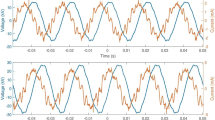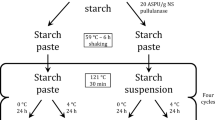Abstract
Because of the positive role of arabinoxylans and especially their water-soluble fractions in establishing bread properties, it seems reasonable to use them as natural bread improvers. In this work, an adequate isolation procedure of water-soluble arabinoxylans from rye grain with efficient purification steps is presented, delivering 2.9 % yield from wholemeal with a content of arabinoxylan of approximately 70 % and an arabinose/xylose ratio of 0.7. Furthermore, soluble arabinoxylans were modified by enzymatic hydrolyses, cross-linking with peroxidase/H2O2 treatment and combination of both for developing preparations applicable for bread making with different quality profiles. Additionally, a detailed analysis of chemical composition and molecular dimension was carried out by HPLC, SEC, HPSEC and viscosity measuring. The preparation after cross-linking showed considerably higher molar mass values, lower solubility and higher viscosity with high Huggin’s constant compared to the not modified sample. Otherwise, the combination of enzymatic hydrolysis and cross-linking resulted in the formation of arabinoxylan preparations with only slight degree of cross-linking and properties comparable with the only hydrolyzed sample.





Similar content being viewed by others
References
Biliaderis CG, Izydorczyk MS, Rattan O (1995) Effect of arabinoxylans on bread-making quality of wheat flours. Food Chem 5:165–171
Michniewicz J, Biliaderis CG, Bushuk W (1991) Effect of added arabinoxylans on some physical and technological characteristics of dough and gluten. Cereal Chem 68:252–258
Cleemput G, Roels SP, Van Oort M, Grobet PJ, Delcour JA (1993) Heterogeneity in the structure of water-soluble arabinoxylans in European wheat flours of variable bread-making quality. Cereal Chem 70:324–329
Izydorczyk MS, Biliaderis CG (1995) Cereal arabinoxylans: advances in structure and physicochemical properties. Carbohydr Polym 28:33–48
Courtin CM, Delcour JA (1998) Physicochemical and characteristics of low molecular weight wheat derived arabinoxylans. J Agric Food Chem 46:4066–4073
Maat J, Roza M, Verbakel J, Stam H, Santos da Silva MJ, Bosse M, Egmond MR, Hagemans MLD, van Gorcom RFM, Hessing JGM, van den Hondel CAMJJ (1992) Xylanases and their application in bakery. In: Visser J et al (eds) Xylans and xylanases. Elsevier Science Publishers, Amsterdam, pp 349–360
Krishnaray L, Hoseney RC (1994) Enzymes increase loaf volume of bread supplemented with starch tailings and insoluble arabinoxylans. J Food Sci 59:1251–1254
Vanhamel S, Cleemput G, Delcour JA, Nys M, Delcour JA (1993) Physico-chemical and functional properties of rye non starch polysaccharides. The effect of high molecular weight water solubles on wheat bread quality in a straight dough procedure. Cereal Chem 70:306–311
Michniewicz J, Biliaderis CG, Bushuk W (1992) Effect of added arabinoxylans on some properties of wheat bread. Food Chem 43:251–257
Vinkx CJA, Delcour JA (1996) Rye (Seceal L.) Arabinoxylans. A critical review. J Cereal Sci 24:1–14
Courtin CM, Delcour JA (2002) Arabinoxylans and endoxylanases in wheat flour breadmaking. J Cereal Sci 35:225–243
Hoseney RC, Faubion JM (1981) A mechanism for the oxidative gelation of wheat flour water-soluble arabinoxylans. Cereal Chem 58:421–424
Kieffer R, Matheis G, Hofmann HW, Belitz HD (1981) Verbesserung der Backeigenschaften von Weizenmehlen durch Zusatz von Peroxidase aus Meerrettich, H2O2 und Phenolen. Z Lebensm Unters Forsch 173:376–379
Michniewicz J, Biliaderis CG, Bushuk W (1990) Water-insoluble arabinoxylans of wheat: composition and some physical properties. Cereal Chem 67:434–439
Izydorczyk MS, Biliaderis CG, Bushuk W (1990) Oxidative gelation of water-soluble arabinoxylans from wheat. J Cereal Sci 11:153–169
Michniewicz J (1995) Pentozany w technologii zbóż, (Arabinoxylans in cereals technology), Rozprawy Naukowe, Zeszyt 261. AR Poznań
Bushuk W (2001) Rye: production, chemistry and technology, 2nd edn. AAOCC St. Paul, Minnesota
Gąsiorowski H (1994) Żyto, Chemia i technologia (Rye, chemistry and technology). PWRiL, Poznań
Gambuś H (1997) Wpływ fizyczno-chemicznych właściwości skrobi na jakość i starzenie się pieczywa, Zeszyty naukowe Akademii Rolniczej im. Hugona Kołłątaja w Krakowie, 6–11
Buksa K, Nowotna A, Praznik W, Gambuś H, Ziobro R, Krawontka J (2009) The role of arabinoxylans and starch in baking of wholemeal rye bread. Food Res Int 43:2045–2051
Vinkx CJA, Reynaert HR, Grobet PJ, Delcour JA (1993) Physicochemical and functional properties of rye nonstarch polysaccharides V. Variability in the structure of water-soluble arabinoxylans. Cereal Chem 70:311–317
Fengler AI, Marquardt RR (1988) Water-soluble arabinoxylans from rye: I. Isolation, partial purification and characterization. Cereal Chem 65:291–297
Jankiewicz M, Michniewicz J (1976) The changes of some properties of wheat dough protein complex as affected by addition of rye arabinoxylan preparation. Ann Poznan Agric Univ 89:75
Vinkx CJA, Stevens I, Gruppen H, Grobet PJ, Delcour JA (1995) Physico-chemical and functional properties of rye nonstarch polysaccharides VI, variability in the structure of water-unextractable arabinoxylans. Cereal Chem 72:411–418
Praznik W, Buksa K, Nowotna A, Gambuś H, Ziobro R, Gumul D (2009) Improved method of isolation of water soluble arabinoxylans from rye wholemeal. In: Proceedings 36th international conference of SSCHE, Tatranske Matliare, Slovakia, p 182
Hashimoto S, Shogren MD, Pomeranz Y (1987) Cereal arabinoxylans: their estimation and significance, I arabinoxylans in wheat and milled wheat products. Cereal Chem 64:30–34
AOAC (2006) Official methods of analysis, 18th edn. Association of Official Analytical Chemists International, Gaithersburg
Andreasen MF, Christensen LP, Meyer AS, Hansen A (2002) Ferulic acid dehydrodimers in rye (Secale cereal L.). J Cereal Sci 31:303–307
Pan GX, Thompson CI, Leary GJ (2002) Uv–vis, spectroscopic characteristics of ferulic acid and related compounds. J Wood Chem Technol 22:137–146
Hartmann G, Piber M, Koehler P (2005) Isolation and chemical characterization of water—extractable arabinoxylans from wheat and rye during breadmaking. Eur Food Res Technol 221:487–492
Chaplin MF, Kennedy JF (1994) Carbohydrate analysis: a practical approach, 2nd edn. ILR Press, Ithaca
Richter M, Augustat S, Schierbaum F (1968) Ausgewählte Methoden der Stärkechemie. VEB Fachbuchverlag, Leipzig
Heitmann T, Mersmann A (1995) Determination of intrinsic viscosity of native potato starch solutions. Starch 47:426–429
Anger H, Dorfer J, Berth G (1986) Untersuchungen zur Molmasse und Grenzviskositat von Arabinoxylan (Arabinoxylan) aus Roggen (Secale cereale) zur Aufstellung der Mark-Houwink-Beziehung. Food 30:205–208
Delcour JA, Rouseu N, Vanhaesendonck IP (1999) Pilot-scale isolation of water-extractable arabinoxylans from rye. Cereal Chem 76:1–2
Girhammar U, Nair BM (1995) Rheological properties of water soluble non-starch polysaccharides from whole grain rye flour. Food Hydrocoll 9:133–140
Dervilly-Pinel G, Rimsten L, Saulnier L, Andersson R, Aman P (2001) J Cereal Sci 34:207–214
Bradford MM (1976) A rapid and sensitive method for quantification of microgram quantities of protein utilizing the principle of protein-dye binding. Anal Biochem 72:248–255
Figueroa-Espinoza MC, Poulsen C, Borch Soe J, Zargahi MR, Rouau X (2002) Enzymatic solubilization of arabinoxylans from isolated rye arabinoxylans and rye flour by different endo-xylanases and other hydrolyzing enzymes. Effect of a fungal laccase on the flour extracts oxidative gelatination. J Agric Food Chem 50:6473–6484
Pan GX, Spencer L, Leary GJ (1999) Reactivity of ferulic acid and its derivatives toward hydrogen peroxide and peracetic acid. J Agric Food Chem 47:3325–3331
Piber M, Koehler P (2005) Identification of dehydro-ferulic acid tyrosine in rye and wheat: evidence for covalent cross-link between arabinoxylans and proteins. J Agric Food Chem 53:5276–5284
Moore AM, Martinez-Munoz I, Hoseney C (1990) Factors affecting the oxidative gelatination of wheat water-solubles. Cereal Chem 67:81–8467
Vinkx CJA, van Nieuwenhove CG, Delcour JA (1991) Physicochemical and functional properties of rye nonstarch polysaccharides. III. Oxidative gelation of a fraction containing water soluble arabinoxylans and proteins. Cereal Chem 68:617–622
Acknowledgments
This study was supported by Ministry of Science and Higher Education grant N N312 440837.
Author information
Authors and Affiliations
Corresponding author
Rights and permissions
About this article
Cite this article
Buksa, K., Ziobro, R., Nowotna, A. et al. Isolation, modification and characterization of soluble arabinoxylan fractions from rye grain. Eur Food Res Technol 235, 385–395 (2012). https://doi.org/10.1007/s00217-012-1765-0
Received:
Accepted:
Published:
Issue Date:
DOI: https://doi.org/10.1007/s00217-012-1765-0




